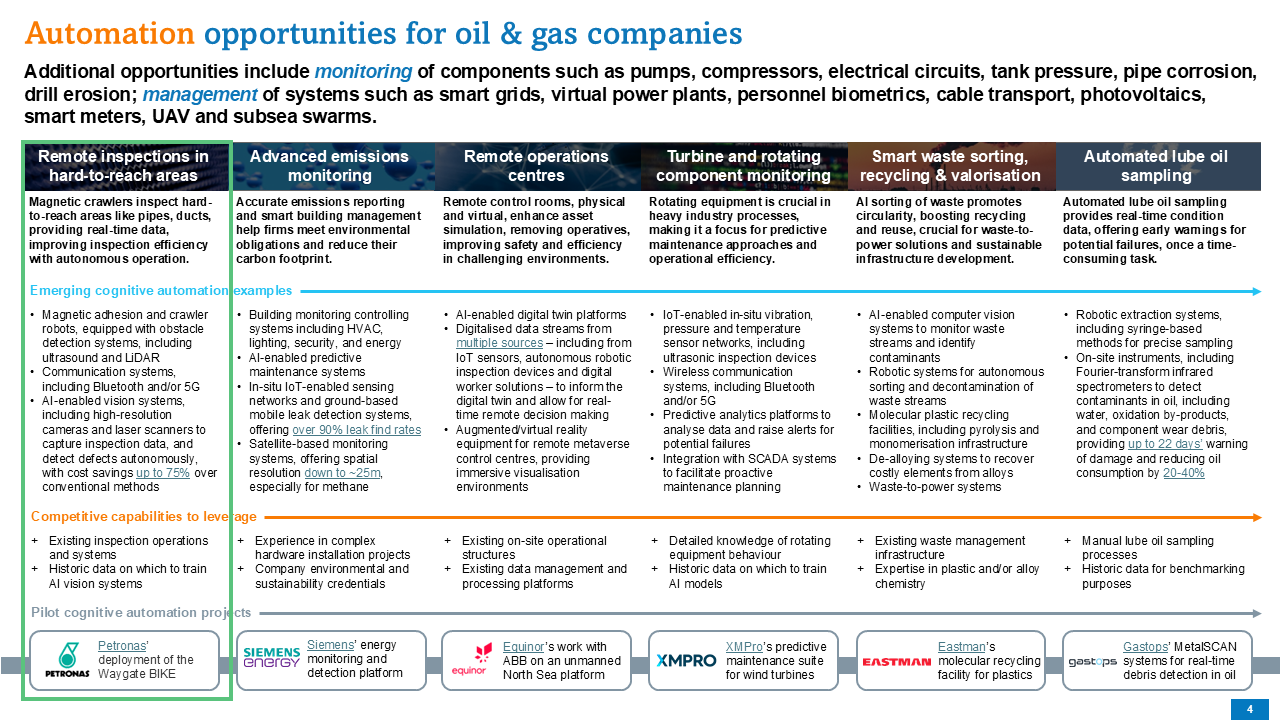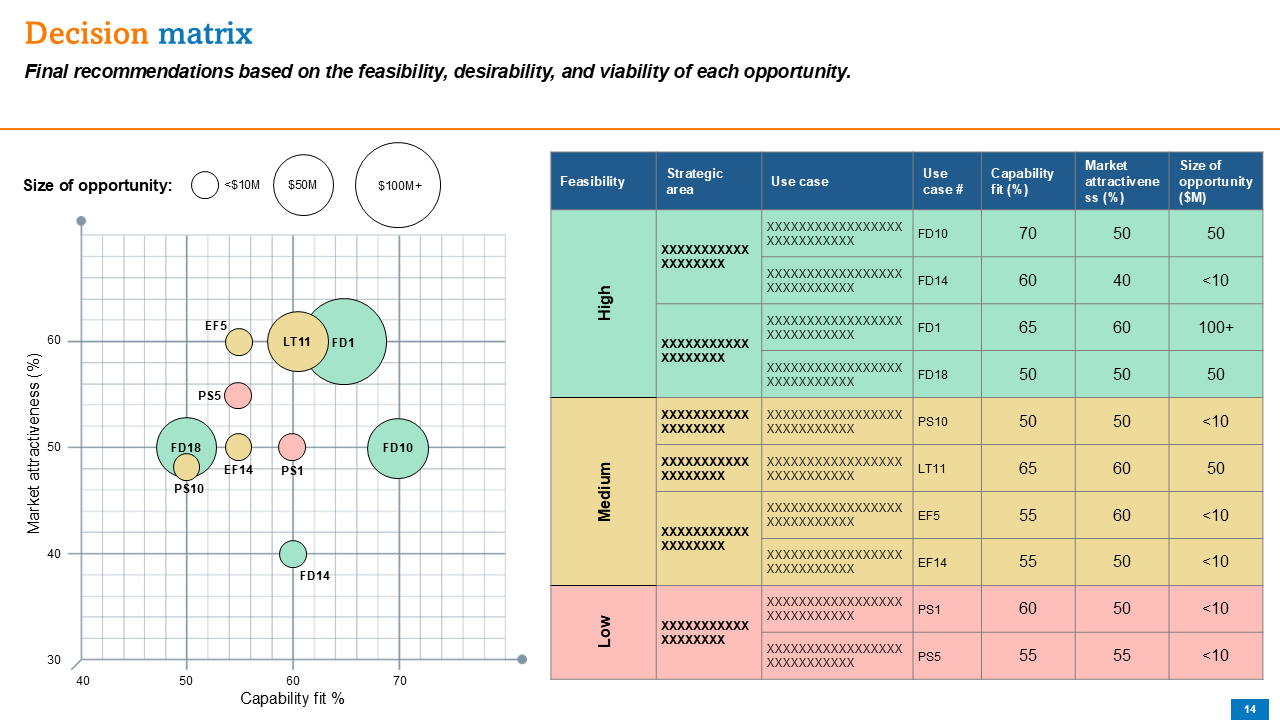De-risked a $50M transformation by identifying top automation use cases and credible solution partners
CamIn works with early adopters to identify new opportunities enabled by emerging technology.
of CamIn’s project team comprised of leading industry and technology experts





Our Oil & Gas client wanted to confirm automation business cases for their offshore assets over the next 5 years. CamIn built 10 automation business cases that de-risked client’s $50 million worth of investments.


The client required support to develop a 5-year technology strategy and adoption roadmap of solutions to automate their offshore oil & gas assets and unlock value. The client needed to de-risk its $50 million digital transformation initiative, focusing on applications such as asset maintenance, facility management, regulatory compliance, hazard & worker safety, and security & access control. Evaluating and validating solutions independently was difficult, as it required specialised expertise to understand diverse surveillance and automation use cases, and how to unlock their full value.

5 | Determined 5 key application areas for automation solutions: Asset maintenance, facility management, regulatory compliance, worker safety, and security and access control. |
56 | Identified and analysed 56 critical tasks for offshore assets, understanding the potential revenue, time, and safety benefits of automation solutions. |
10 | Isolated the 10 most promising use cases and 175 vendors, on their alignment with client demands, and assessing their feasibility, desirability and viability for the client. |
7 | Confirmed 7 most credible vendors of solutions for the highest-priority use cases, to form the basis for development partnerships and pilot projects. |

CamIn identified 10 high-impact use cases and assessed 175 vendors, confirming the 7 most credible vendors for initial pilots.

The client is now running pilot projects with a view to rolling out automation solutions across its offshore assets.

CamIn derisked the client's $50 million automation investment, with significant cost savings and safety enhancements anticipated.
Download our detailed case study and discover how offshore automation improved efficiency, safety, and uptime for our client.





.svg)
Automation for offshore oil and gas refers to the integration of advanced digital technologies, such as robotics, sensors, artificial intelligence, and edge computing, into operational processes on offshore platforms. These technologies enable remote monitoring, predictive maintenance, autonomous inspection, and real-time control of critical infrastructure. By reducing manual intervention in hazardous and hard-to-access environments, automation enhances operational resilience, safety, and efficiency across the full offshore value chain.
The oil and gas industry is under increasing pressure to improve safety, cut costs, and comply with stricter environmental regulations. Offshore operations, in particular, are exposed to harsh environments and high operational risk. Automation offers a strategic solution by reducing human intervention, streamlining asset management, and enabling real-time decision-making. It also forms the backbone of digital transformation efforts that help companies stay competitive in a volatile global energy landscape.
Over the next decade, automation will transform oil and gas into a more adaptive, data-driven, and efficient sector. As the industry navigates volatile markets, aging infrastructure, and rising sustainability demands, automation will be critical for improving safety, cutting costs, and extending asset life. From drilling platforms to processing facilities, intelligent systems will take over routine tasks, optimise decision-making, and enable leaner, more resilient operations.
A suite of advanced and converging technologies is enabling the next wave of automation in offshore oil and gas operations, seeking to transform how assets are monitored, maintained, and managed in remote and high-risk environments. Key emerging technologies include:

Adoption of remote inspection in hard-to-reach offshore areas is driven by cost savings, safety imperatives, regulatory compliance, digital integration, and the need for reliable, low-carbon asset integrity management.
Remote inspection technologies leverage drones, crawlers, ROVs, sensors, and digital analytics to enhance safety, reduce costs, and enable predictive asset integrity management in hard-to-reach areas.
Drone-based flare stack inspection is already commercially proven (TRL 8–9), with developers demonstrating safer, cost-saving alternatives to traditional shutdown inspections, driving widespread adoption within 1–3 years.
While barriers like heat exposure, ATEX compliance, and flight limitations pose challenges, most can be mitigated through specialised drone designs, skilled operators, and integration with existing asset management systems.
| Difficulty | Barriers to Adoption |
|---|---|
| High | Battery constraints restrict inspection time, particularly offshore where recharging logistics are challenging. |
| Medium | Drone components risk heat damage when inspecting active flares, requiring specialised thermal shielding and flight paths. |
| Medium | Strong winds and unpredictable gusts around flare stacks make stable flight and clear imaging difficult. |
| Medium | Operating drones in hazardous zones demands certified explosion-proof designs, which increases cost and limits vendor options. |
| Medium | Inspection outputs must integrate with digital twins, CMMS, and integrity databases; lack of interoperability slows adoption. |
| Medium | Some regulators remain cautious on drone data equivalence to rope access/NDT methods, requiring extensive validation. |
| Medium | Operating drones near live flare stacks offshore requires highly skilled, certified pilots, creating dependency on specialist contractors. |
| Medium | Complex offshore topside layouts can block drone line-of-sight, limiting inspection angles and requiring advanced navigation systems. |
| Medium | Despite safety and downtime savings, upfront drone service costs may appear high versus existing rope access routines. |
| Medium | Glare, vibration, and heat shimmer can reduce image fidelity, impacting reliability of defect detection. |
Drone-based flare stack inspections present a large and fast-growing opportunity: they cut costs, improve safety, reduce emissions, and enjoy strong political, regulatory, and technological tailwinds, giving the use case a high desirability score.<
Size of Opportunity
Offshore oil and gas operators manage &lt;650 offshore platforms in the North Sea alone, with thousands more globally in the Gulf of Mexico, Middle East, and Asia. Each asset requires regular flare stack inspections to meet safety and regulatory standards, with shutdown-based inspections costing operators up to $1-2 million per day in lost production. The global industrial drone market was valued at ~$3.6bn in 2024 and is projected to reach ~$6bn by 2029, with oil and gas among the top verticals driving adoption. The large number of vendors offering flare stack and live asset inspections underlines both technical maturity and strong demand. In short, drone-based flare inspections represent a multi-hundred-million-dollar addressable service market, driven by cost savings, safety imperatives, and ESG commitments to reduce offshore travel and shutdown emissions.
External Threats and Opportunities
| Factor | Assessment | Overall outlook |
|---|---|---|
| Political | Regulators increasingly accept drone inspections as valid for asset integrity surveys. | Positive |
| Economic | Avoiding shutdowns saves millions per inspection campaign; service costs are offset quickly, creating strong ROI incentives. | Positive |
| Social | Strong workforce safety expectations push operators to reduce rope access and at-height risks; drones directly address this. | Positive |
| Technological | Advances in UAV heat shielding, AI defect recognition, and autonomous navigation are reducing operational limits. | Positive |
| Legal | Inspection standards are evolving to include drone-derived data; validation is needed, but regulators are supportive. | Positive |
| Environmental | Reduced helicopter trips and shutdown flaring lower emissions, aligning drone inspections with net-zero and ESG targets. | Positive |
Oil and gas firms are well-positioned to adopt drone-based flare stack inspections due to strong asset integrity and regulatory expertise, but rely on specialist vendors for drone hardware and specialist analytics capabilities.
Capability fit assessment
Oil and gas firms bring deep strength in asset integrity management, regulatory compliance, and offshore operations, making them credible adopters of drone inspection solutions. Where capability gaps exist is primarily in the specialist areas of drone hardware, payloads, and AI-driven defect analytics, which are typically provided by third-party vendors (e.g. Cyberhawk, Sky-Futures, Percepto). Most majors already run digital twin and integrity management programmes, providing a solid integration base. In short, operators are well-positioned in the “why” (safety, cost, compliance) and “where” (offshore asset base), but will rely on vendor partnerships or acquisitions to deliver the “how” (autonomous drones, advanced vision analytics, hazardous environment certification).
| Capability | Rationale | Current fit estimate | Current fit summary |
|---|---|---|---|
| Asset integrity management expertise | Experience managing flare stacks, corrosion, and inspection routines. | Strong | Operators already run extensive inspection/maintenance programmes with in-house engineers and integrity teams. |
| Regulatory & compliance expertise | Navigating offshore inspection standards, class society approvals, and safety cases. | Strong | Deep engagement with ABS, DNV, Lloyd’s Register ensures compliance pathways for drone-derived inspection data. |
| Customer & vendor partnerships | Collaboration with drone vendors, regulators, insurers. | Strong | Established industry partnerships; frequent pilots with vendors like Cyberhawk and Sky-Futures. |
| Offshore operations & HSE culture | Managing safety-critical work in hazardous zones. | Strong | Strong safety culture and protocols for flare and topside work, giving credibility to new inspection methods. |
| Digital twin & asset management platforms | Integration of inspection data into CMMS and 3D twins. | Moderate | Many operators have digital twin pilots, but maturity and consistency across fleets vary. |
| Edge computing & data processing | Real-time video/sensor analysis offshore with limited bandwidth. | Moderate | Some in-house experience (IoT pilots), but third-party drone providers lead in edge processing. |
| Commercial scaling & service models | Ability to standardise drone inspections across global fleet. | Moderate | Strong global footprint; adoption depends on procurement and standardisation of vendor contracts. |
| AI/ML & image analytics expertise | Automated defect detection from visual/thermal data. | Moderate | Limited internal capability; reliance on vendor AI platforms (e.g. Cyberhawk iHawk). |
| Drone operations & hardware expertise | Safe operation near flare tips requires specialist drone design and pilots. | Weak | Not a core competence; outsourced to specialist contractors or JV partners. |
| Specialist hardware & payload R&D | Heat-resistant drones, optical/thermal payloads, ATEX certification. | Weak | O&G firms do not develop UAV hardware; wholly reliant on external providers. |

CamIn has identified and analysed 5 key application areas for automated solutions and identified 56 critical offshore tasks that could be automated. We identified the 10 highest priority use cases and evaluated 175 potential vendors, assessing their feasibility, desirability, and viability relative to the client's needs. Finally, we recommended the 7 most credible vendors for pilot projects focusing on the highest priority use cases.